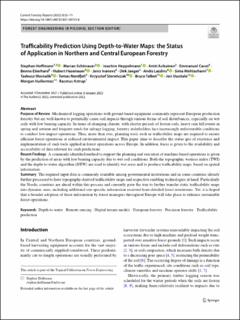| dc.contributor.author | Hoffmann, Stephan | |
| dc.contributor.author | Schönauer, Marian | |
| dc.contributor.author | Heppelmann, Joachim | |
| dc.contributor.author | Asikainen, Antti | |
| dc.contributor.author | Cacot, Emmanuel | |
| dc.contributor.author | Eberhard, Benno | |
| dc.contributor.author | Hasenauer, Hubert | |
| dc.contributor.author | Ivanovs, Janis | |
| dc.contributor.author | Jaeger, Dirk | |
| dc.contributor.author | Lazdins, Andis | |
| dc.contributor.author | Mohtashami, Sima | |
| dc.contributor.author | Moskalik, Tadeusz | |
| dc.contributor.author | Nordfjell, Tomas | |
| dc.contributor.author | Stereńczak, Krzysztof | |
| dc.contributor.author | Talbot, Bruce | |
| dc.contributor.author | Uusitalo, Jori | |
| dc.contributor.author | Vuillermoz, Morgan | |
| dc.contributor.author | Astrup, Rasmus Andreas | |
| dc.date.accessioned | 2022-10-11T08:09:24Z | |
| dc.date.available | 2022-10-11T08:09:24Z | |
| dc.date.created | 2022-01-27T09:45:57Z | |
| dc.date.issued | 2022-01-08 | |
| dc.identifier.citation | Current Forestry Reports. 2022, 8 55-71. | en_US |
| dc.identifier.issn | 2198-6436 | |
| dc.identifier.uri | https://hdl.handle.net/11250/3025282 | |
| dc.description.abstract | Purpose of Review Mechanized logging operations with ground-based equipment commonly represent European production forestry but are well-known to potentially cause soil impacts through various forms of soil disturbances, especially on wet soils with low bearing capacity. In times of changing climate, with shorter periods of frozen soils, heavy rain fall events in spring and autumn and frequent needs for salvage logging, forestry stakeholders face increasingly unfavourable conditions to conduct low-impact operations. Thus, more than ever, planning tools such as trafficability maps are required to ensure efficient forest operations at reduced environmental impact. This paper aims to describe the status quo of existence and implementation of such tools applied in forest operations across Europe. In addition, focus is given to the availability and accessibility of data relevant for such predictions. Recent Findings A commonly identified method to support the planning and execution of machine-based operations is given by the prediction of areas with low bearing capacity due to wet soil conditions. Both the topographic wetness index (TWI) and the depth-to-water algorithm (DTW) are used to identify wet areas and to produce trafficability maps, based on spatial information. Summary The required input data is commonly available among governmental institutions and in some countries already further processed to have topography-derived trafficability maps and respective enabling technologies at hand. Particularly the Nordic countries are ahead within this process and currently pave the way to further transfer static trafficability maps into dynamic ones, including additional site-specific information received from detailed forest inventories. Yet, it is hoped that a broader adoption of these information by forest managers throughout Europe will take place to enhance sustainable forest operations. | en_US |
| dc.description.abstract | Trafficability Prediction Using Depth-to-Water Maps: the Status of Application in Northern and Central European Forestry | en_US |
| dc.language.iso | eng | en_US |
| dc.publisher | Springer Nature | en_US |
| dc.rights | Navngivelse 4.0 Internasjonal | * |
| dc.rights.uri | http://creativecommons.org/licenses/by/4.0/deed.no | * |
| dc.title | Trafficability Prediction Using Depth-to-Water Maps: the Status of Application in Northern and Central European Forestry | en_US |
| dc.title.alternative | Trafficability Prediction Using Depth-to-Water Maps: the Status of Application in Northern and Central European Forestry | en_US |
| dc.type | Peer reviewed | en_US |
| dc.type | Journal article | en_US |
| dc.description.version | publishedVersion | en_US |
| dc.rights.holder | © The Author(s) 2022 | en_US |
| dc.source.pagenumber | 55-71 | en_US |
| dc.source.volume | 8 | en_US |
| dc.source.journal | Current Forestry Reports | en_US |
| dc.identifier.doi | 10.1007/s40725-021-00153-8 | |
| dc.identifier.cristin | 1990983 | |
| dc.relation.project | EC/H2020/720757 | en_US |
| dc.relation.project | EC/H2020/720712 | en_US |
| cristin.ispublished | true | |
| cristin.fulltext | original | |
| cristin.qualitycode | 1 | |

